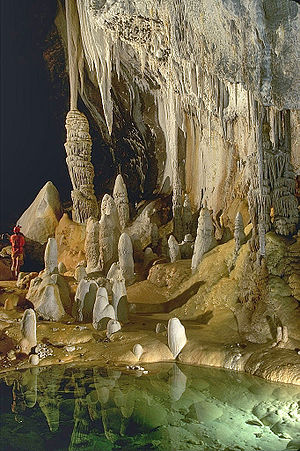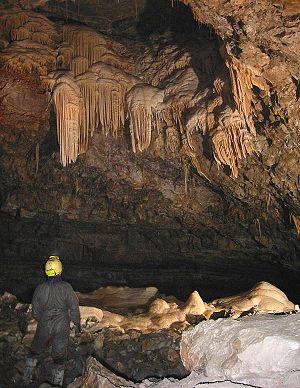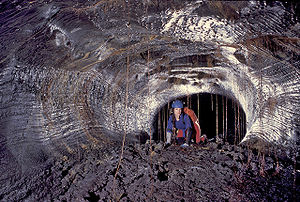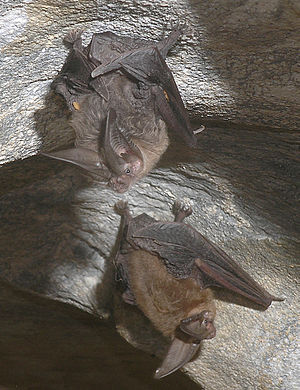
Cave
Background to the schools Wikipedia
Arranging a Wikipedia selection for schools in the developing world without internet was an initiative by SOS Children. Click here for more information on SOS Children.
A cave is a natural underground void large enough for a human to enter. Some people suggest that the term cave should only apply to cavities that have some part that does not receive daylight; however, in popular usage, the term includes smaller spaces like sea caves, rock shelters, and grottos.
Speleology is the science of exploration and study of all aspects of caves. Exploring a cave for recreation or science may be called caving, potholing, or occasionally (only in Canada and the United States), spelunking (see Caving).
Types and formation
The formation and development of caves is known as speleogenesis. Caves are formed by various geologic processes. These may involve a combination of chemical processes, erosion from water, tectonic forces, microorganisms, pressure, atmospheric influences, and even digging.
Most caves are formed in limestone by dissolution.
- Solutional caves may form anywhere with rock that is soluble, and are most prevalent in limestone, but can also form in other material, including chalk, dolomite, marble, granite, salt, sandstone, fossilized coral and gypsum.
- The largest and most abundant solutional caves are located in limestone. Limestone dissolves under the action of rainwater and groundwater charged with H2CO3 ( carbonic acid) and naturally occurring organic acids. The dissolution process produces a distinctive landform known as karst, characterized by sinkholes, sinking streams, and underground drainage. Limestone caves are often adorned with calcium carbonate formations produced through slow precipitation. This include: flowstones, stalactites, stalagmites, helictites, draperies, soda straws and columns. These secondary mineral deposits in caves are called speleothems.
- The world's most spectacularly decorated cave is generally regarded to be Lechuguilla Cave in New Mexico. Lechuguilla and nearby Carlsbad Caverns are now believed to be examples of another type of solutional cave. They were formed by H2S ( hydrogen sulfide) gas rising from below, where reservoirs of oil give off sulfurous fumes. This gas mixes with ground water and forms H2SO4 (sulfuric acid). The acid then dissolves the limestone from below, rather than from above, by acidic water percolating from the surface.
- Some caves are formed at the same time as the surrounding rock. These are sometimes called primary caves.
- Lava tubes are formed through volcanic activity and are the most common 'primary' caves. The lava flows downhill and the surface cools and solidifies. The hotter lava continues to flow under that crust, and if most of the liquid lava beneath the crust flows out, a hollow tube remains, thus forming a cavity. Examples of such caves can be found on Tenerife, Big Island, and many other places. Kazumura Cave near Hilo is a remarkably long and deep lava tube; it is 65.6 kilometers (40.8 mi) long.
- Blister caves are also formed through volcanic activity.
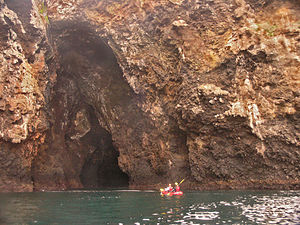
- Sea caves are found along coasts around the world. A special case is littoral caves, which are formed by wave action in zones of weakness in sea cliffs. Often these weaknesses are faults, but they may also be dykes or bedding-plane contacts. Some wave-cut caves are now above sea level because of later uplift. Elsewhere, in places such as Thailand's Phang Nga Bay, solutional caves have been flooded by the sea and are now subject to littoral erosion. Sea caves are generally around 5 meters (16 ft) to 50 meters (160 ft) in length but may exceed 300 meters (980 ft).
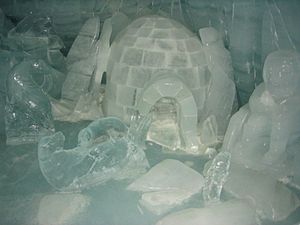
- Glacier caves occur in ice and under glaciers and are formed by melting. They are also influenced by the very slow flow of the ice, which tends to close the caves again. (These are sometimes called ice caves, though this term is properly reserved for caves that contain year-round ice formations).
- Fracture caves are formed when layers of more soluble minerals, such as gypsum, dissolve out from between layers of less soluble rock. These rocks fracture and collapse in blocks.
- Talus caves are the openings between rocks that have fallen down into a pile, often at the bases of cliffs.
- Anchihaline caves are caves, usually coastal, containing a mixture of freshwater and saline water (usually sea water). They occur in many parts of the world, and often contain highly specialized and endemic faunas.
Patterns
- Branchwork caves resemble surface dentritic stream patterns; they are made up of passages that join downstream as tributaries. Branchwork caves are the most common of cave patterns and are formed near sinkholes where groundwater recharge occurs. Each passage or branch is fed by a separate recharge source and converges into other higher order branches downstream.
- Angular Network caves form from intersecting fissures of carbonate rock that have had fractures widened by chemical erosion. These fractures form high, narrow, straight passages that persist in widespread closed loops.
- Anastomotic caves largely resemble surface braided streams with their passages separating and then meeting further down drainage. They usually form along one bed or structure, and only rarely cross into upper or lower beds.
- Spongework caves are formed as solution cavities are joined by mixing of chemically diverse water. The cavities form a pattern that is three-dimensional and random, resembling a sponge.
- Ramiform caves form as irregular large rooms, galleries, and passages. These randomized three-dimensional rooms form from a rising water table that erodes the carbonate rock with hydrogen-sulfide enriched water.
Geographic distribution
Caves are found throughout the world, but only a portion of them have been explored and documented by cavers. The distribution of documented cave systems is widely skewed toward countries where caving has been popular for many years (such as France, Italy, Australia, the UK, the United States, etc.). As a result, explored caves are found widely in Europe, Asia, North America, and Oceania but are sparse in South America, Africa, and Antarctica. This is a great generalization, as large expanses of North America and Asia contain no documented caves, whereas areas such as the Madagascar dry deciduous forests and parts of Brazil contain many documented caves. As the world’s expanses of soluble bedrock are researched by cavers, the distribution of documented caves is likely to shift. For example, China, despite containing around half the world's exposed limestone - more than 1,000,000 square kilometers (390,000 sq mi) - has relatively few documented caves.
Record lengths, depths, pitches and volumes
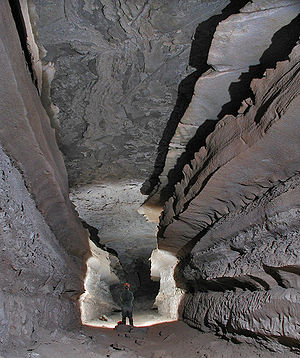
The cave system with the greatest total length of passage is Mammoth Cave ( Kentucky, USA) at 591 kilometers (367 mi) in length. This record is unlikely to be surpassed in the near future, as the next most extensive known cave is Jewel Cave near Custer, South Dakota, at 225 kilometers (140 mi).
The deepest known cave (measured from its highest entrance to its lowest point) is Voronya Cave (Abkhazia, Georgia), with a depth of 2,191 meters (7,188 ft). This was the first cave to be explored to a depth of more than 2 kilometers (1.2 mi). (The first cave to be descended below 1 kilometer (0.62 mi) was the famous Gouffre Berger in France). The Illyuzia-Mezhonnogo-Snezhnaya cave in Abkhazia, Georgia, (1,753 meters (5,751 ft)) and the Lamprechtsofen Vogelschacht Weg Schacht in Austria (1,632 meters (5,354 ft)) are the current second- and third-deepest caves. This particular record has changed several times in recent years.
The deepest individual pitch (vertical drop) within a cave is 603 meters (1,978 ft) in Vrtoglavica Cave in Slovenia, followed by Patkov Gušt at 553 meters (1,814 ft) in the Velebit mountain, Croatia.
The largest individual cavern ever discovered is the Sarawak chamber, in the Gunung Mulu National Park ( Miri, Sarawak, Borneo, Malaysia), a sloping, boulder strewn chamber with an area of approximately 600 meters (2,000 ft) by 400 meters (1,300 ft) and a height of 80 meters (260 ft).
Ecology
Cave-inhabiting animals are often categorized as troglobites (cave-limited species), troglophiles (species that can live their entire lives in caves, but also occur in other environments), trogloxenes (species that use caves, but cannot complete their life cycle wholly in caves) and accidentals (animals not in one of the previous categories). Some authors use separate terminology for aquatic forms (e.g., stygobites, stygophiles, and stygoxenes).
Of these animals, the troglobites are perhaps the most unusual organisms. Troglobitic species often show a number of characteristics, termed troglomorphies, associated with their adaptation to subterranean life. These characteristics may include a loss of pigment (often resulting in a pale or white coloration), a loss of eyes (or at least of optical functionality), an elongation of appendages, and an enhancement of other senses (such as the ability to sense vibrations in water). Aquatic troglobites (or stygobites), such as the endangered Alabama cave shrimp, live in bodies of water found in caves and get nutrients from detritus washed into their caves and from the feces of bats and other cave inhabitants. Other aquatic troglobites include cave fish, the Olm, and cave salamanders such as the Texas Blind Salamander.
Cave insects such as Oligaphorura (formerly Archaphorura) schoetti are troglophiles, reaching 1.7 millimeters (0.067 in) in length. They have extensive distribution and have been studied fairly widely. Most specimens are female but a male specimen was collected from St Cuthberts Swallet in 1969.
Bats, such as the Gray bat and Mexican Free-tailed Bat, are trogloxenes and are often found in caves; they forage outside of the caves. Some species of cave crickets are classified as trogloxenes, because they roost in caves by day and forage above ground at night.
Because of the fragile nature of the cave ecosystem, and the fact that cave regions tend to be isolated from one another, caves harbour a number of endangered species, such as the Tooth cave spider, Liphistiidae Liphistius trapdoor spider, and the Gray bat.
Caves are visited by many surface-living animals, including humans. These are usually relatively short-lived incursions, due to the lack of light and sustenance.
Archaeological and social importance
Throughout history, primitive peoples have made use of caves for shelter, burial, or as religious sites. Since items placed in caves are protected from the climate and scavenging animals, this means caves are an archaeological treasure house for learning about these people. Cave paintings are of particular interest. One example is the Great Cave of Niah, in Malaysia, which contains evidence of human habitation dating back 40,000 years.
In Germany some experts found signs of cannibalism in the caves at the Hönne.
Caves are also important for geological research because they can reveal details of past climatic conditions in speleothems and sedimentary rock layers.
Caves are frequently used today as sites for recreation. Caving, for example, is the popular sport of cave exploration. For the less adventurous, a number of the world's prettier and more accessible caves have been converted into show caves, where artificial lighting, floors, and other aids allow the casual visitor to experience the cave with minimal inconvenience. Caves have also been used for BASE jumping and cave diving.
Caves are also used for the preservation or aging of wine and cheese. The constant, slightly chilly temperature and high humidity that most caves possess makes them ideal for such uses.
